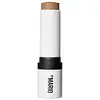What's inside
What's inside
 Key Ingredients
Key Ingredients

 Benefits
Benefits

 Concerns
Concerns

 Ingredients Side-by-side
Ingredients Side-by-side

Octyldodecyl Myristate
EmollientIsononyl Isononanoate
EmollientPentaerythrityl Tetraisostearate
EmollientSynthetic Wax
AbrasiveDiisostearyl Malate
EmollientSynthetic Fluorphlogopite
Silica
AbrasiveBis-Diglyceryl Polyacyladipate-2
EmollientDiisostearoyl Polyglyceryl-3 Dimer Dilinoleate
EmollientCaprylic/Capric Glycerides
EmollientCaprylic/Capric Triglyceride
MaskingSorbitan Isostearate
EmulsifyingMicrocrystalline Wax
Emulsion StabilisingEthylene/Propylene Copolymer
AbrasivePolyglyceryl-2 Triisostearate
EmulsifyingLecithin
EmollientMethicone
EmollientTriethoxycaprylylsilane
Aluminum Hydroxide
EmollientWater
Skin ConditioningBHT
AntioxidantTitanium Dioxide
Cosmetic ColorantCI 77492
Cosmetic ColorantCI 77491
Cosmetic ColorantCI 77499
Cosmetic ColorantOctyldodecyl Myristate, Isononyl Isononanoate, Pentaerythrityl Tetraisostearate, Synthetic Wax, Diisostearyl Malate, Synthetic Fluorphlogopite, Silica, Bis-Diglyceryl Polyacyladipate-2, Diisostearoyl Polyglyceryl-3 Dimer Dilinoleate, Caprylic/Capric Glycerides, Caprylic/Capric Triglyceride, Sorbitan Isostearate, Microcrystalline Wax, Ethylene/Propylene Copolymer, Polyglyceryl-2 Triisostearate, Lecithin, Methicone, Triethoxycaprylylsilane, Aluminum Hydroxide, Water, BHT, Titanium Dioxide, CI 77492, CI 77491, CI 77499
C12-15 Alkyl Benzoate
AntimicrobialCaprylic/Capric Triglyceride
MaskingDicalcium Phosphate
AbrasiveDimethicone/Vinyl Dimethicone Crosspolymer
Skin ConditioningOzokerite
Emulsion StabilisingPolyethylene
AbrasivePolymethyl Methacrylate
Polyglyceryl-2 Diisostearate
EmulsifyingPolymethylsilsesquioxane
Dipentaerythrityl Hexahydroxystearate
EmulsifyingOctyldodecanol
EmollientTriethoxycaprylylsilane
Laureth-4
EmulsifyingDisteardimonium Hectorite
StabilisingAlcohol
AntimicrobialPentaerythrityl Tetra-Di-T-Butyl Hydroxyhydrocinnamate
AntioxidantWater
Skin ConditioningTitanium Dioxide
Cosmetic ColorantIron Oxides
C12-15 Alkyl Benzoate, Caprylic/Capric Triglyceride, Dicalcium Phosphate, Dimethicone/Vinyl Dimethicone Crosspolymer, Ozokerite, Polyethylene, Polymethyl Methacrylate, Polyglyceryl-2 Diisostearate, Polymethylsilsesquioxane, Dipentaerythrityl Hexahydroxystearate, Octyldodecanol, Triethoxycaprylylsilane, Laureth-4, Disteardimonium Hectorite, Alcohol, Pentaerythrityl Tetra-Di-T-Butyl Hydroxyhydrocinnamate, Water, Titanium Dioxide, Iron Oxides
 Reviews
Reviews

Alternatives
Ingredients Explained
These ingredients are found in both products.
Ingredients higher up in an ingredient list are typically present in a larger amount.
This ingredient is an emollient, solvent, and texture enhancer. It is considered a skin-softener by helping the skin prevent moisture loss.
It helps thicken a product's formula and makes it easier to spread by dissolving clumping compounds.
Caprylic Triglyceride is made by combining glycerin with coconut oil, forming a clear liquid.
While there is an assumption Caprylic Triglyceride can clog pores due to it being derived from coconut oil, there is no research supporting this.
Learn more about Caprylic/Capric TriglycerideTitanium dioxide is a mineral UV filter widely used in sunscreens and cosmetics.
It is one of only two UV filters officially classified as “mineral” by regulatory agencies, the other being zinc oxide.
Titanium dioxide provides broad-spectrum protection mostly in the UVB and UVAII range, with some protection in the UVAI range.
While its UVA protection isn’t as strong as zinc oxide’s, the difference is minor.
A common myth is that mineral UV filters reflect UV light. However, modern research shows titanium dioxide absorbs UV radiation like chemical filters (~95% absorption & 5% reflection).
Thanks to its non-irritating nature, titanium dioxide is suitable for sensitive, acne-prone, or redness-prone skin. It is unlikely to cause "eye sting" like other sunscreen ingredients.
A major drawback of this ingredient is its white cast and thick texture. This is why mineral sunscreens often leave a white cast and are less cosmetically elegant than chemical/hybrid sunscreens.
To improve white cast and spreadability, micronized or nano-sized titanium dioxide is often used.
There are ongoing concerns surrounding nano-titanium oxide's impact on marine ecosystems.
There is no conclusive evidence that any form of titanium oxide (or any other sunscreen ingredients) will cause harm to marine ecosystems or coral reefs. The science is still developing but many consumers are keeping a close eye on this issue.
Please note, many destinations have reef-safety sunscreen rules. For instance, the U.S. Virgin Islands advises all visitors to use non-nano mineral sunscreens.
Nano mineral sunscreens once raised safety concerns about absorption into skin.
Extensive research has shown that they do not penetrate healthy or damaged skin; they remain safely on the surface and the top layer of dead skin (stratum corneum).
You'll likely find titanium dioxide bundled with alumina, silica, or dimethicone. These ingredients help make titanium dioxide highly photostable; this prevents it from interacting with other formula components under UV light.
Learn more about Titanium DioxideTriethoxycaprylylsilane is a silicone used to bind and stabilize ingredients.
As an emulsifier, it helps prevent ingredients from separating. This can help elongate the shelf life of products.
Triethoxycaprylylsilane is often used to coat mineral sunscreens ingredients to help give a better feel. It also helps reduce oxidative stress in sunscreens.
Learn more about TriethoxycaprylylsilaneWater. It's the most common cosmetic ingredient of all. You'll usually see it at the top of ingredient lists, meaning that it makes up the largest part of the product.
So why is it so popular? Water most often acts as a solvent - this means that it helps dissolve other ingredients into the formulation.
You'll also recognize water as that liquid we all need to stay alive. If you see this, drink a glass of water. Stay hydrated!
Learn more about Water